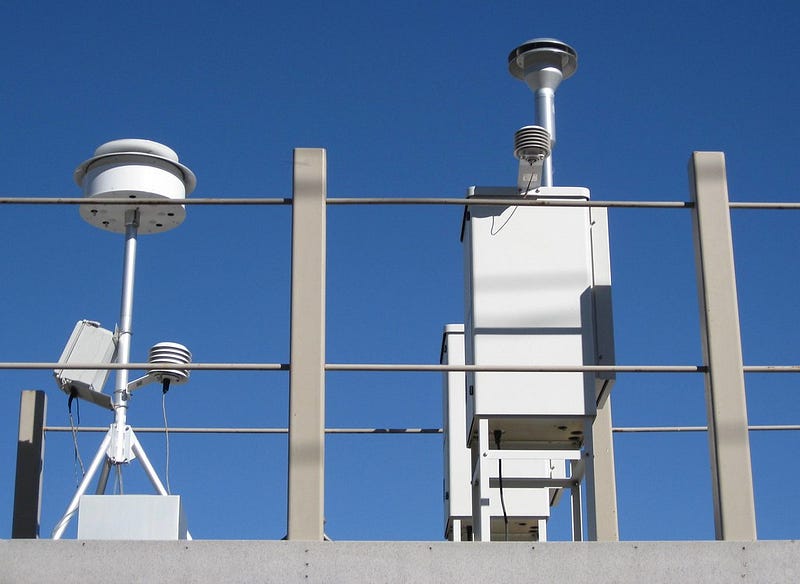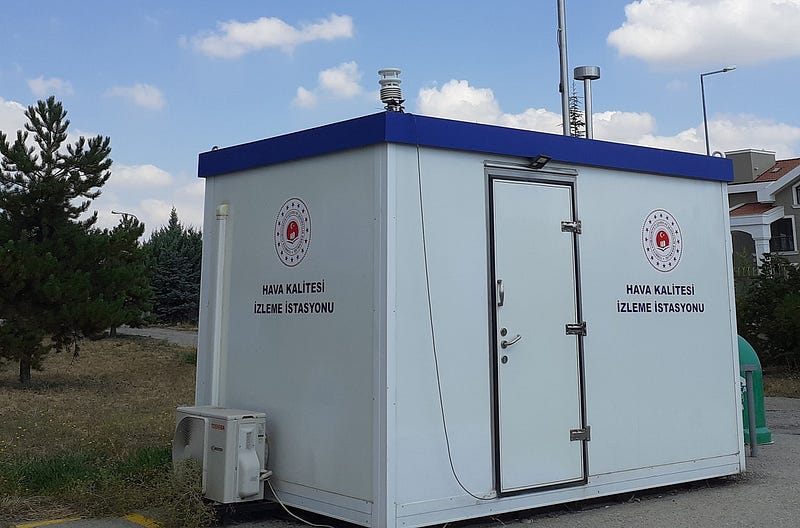According to the World Health Organization, air pollution is the world’s most significant environmental health risk, with 99% of people breathing polluted air and causing one in eight deaths (URL 1, 2). Atmospheric pollution causes regional events and imbalances that threaten humanity and global life. Developments in energy production, chemicals, and social life have reached the power to adversely affect the environment on a large scale with their by-products and wastes.
The most effective method to prevent air pollution is to monitor the levels of pollutants in the atmosphere. The traditional approach to air quality monitoring is to create a network of fixed regulatory stations equipped with certified instruments and operated according to a strict set of regulatory protocols (EPA, 2021). However, a limited number of measurements can be made with this high-cost system; therefore, exposure to air pollutants cannot be understood at many points where air quality may be low. Especially in evaluating the environmental impacts of industrial facilities, this method is very inadequate.
The traditional method is not suitable for a monitoring network covering large areas. For this reason, measurements close to the reference are used to evaluate environmental impact. Close reference air quality monitoring is a category that has recently emerged from merging advanced sensor technology and new measurement paradigms (URL 3). These references, which provide an incredible convenience in understanding pollution dispersion, enable the creation of an extensive monitoring network by providing higher spatial and temporal resolution data more cheaply and integrating it into the traditional system. Especially in the short term, this method effectively understands the pollution level.
The indicator is a category defined by the EU Directive 2008/50/EC on monitoring ambient air quality. This applies to a metric that meets a lower data quality target than the reference (EU, 2008). Passive sampling is one of the most common methods to determine pollutant levels in the atmosphere. It is widely used both in the external environment and indoor environment, as well as in health risk determination studies. The main advantages of passive samplers are; There are many factors, such as being small in size and easy to use, being cheaper than the traditional method, and not needing any power source.
The passive sampling method is based on collecting airborne impurities on the adsorbent by diffusion. In addition to organic pollutants, the inorganic contaminants in the air can be determined with passive sampling tubes. This method is widely used to understand air quality, especially in industrial plant areas. Calculating the Contribution to Air Pollution Value in the impact area of existing and newly established factories using air quality distribution modeling, measurement of air quality in the area of impact of the facility, and determination of measurement methods is obligatory by environmental legislation (URL 4). However, due to the size and cost of traditional methods, monitoring air pollution in the impact areas of industrial areas remains limited. This increases the need for other measurement methods.

At least four passive sampling points are selected for two months in the study area with the highest Contribution to Air Quality, calculated according to the results of Air Quality Distribution Modeling. In other study areas where air pollution is intense, two passive sampling points are selected in each study area, provided that there are at least two study areas. In the study areas where air pollution is intense, the number and location of passive sampling are determined depending on the capacity of the enterprise and the pollutant emission load. Sampling time; The tubes are changed once a month, and selection is made for two months (The T.R. Ministry of Environment, Urbanization and Climate Change, 2014).
To calculate the concentration of the pollutant in the air with passive sampling tubes, the amount of the pollutant on the absorbent should be measured with a gas chromatography device. The retention constant for each pollutant is different. The retention constant is theoretically calculated using experimental results from the geometry of the tube. Since the theoretical retention constant depends only on the shape of the box, it is independent of other meteorological parameters and absorbents. The experimental retention constant is calculated by exposure to passive sampling tubes. In addition to passive sampling, the holding constant is calculated by active selection. Studies have shown that the experimental retention constant differs from the theoretical retention constant (URL 5). For example, the difference between the retention constants found in studies for benzene has reached 100% (URL 4).
Currently, low-cost air sensors are receiving more and more attention to replace traditional methods of air pollution monitoring, and their development continues to expand and evolve rapidly. The EPA refers to the term ‘air sensor’ as a class of non-regulatory technology that is less costly, portable, capable of measuring several pollutants simultaneously, and often easier to operate than regulatory monitors (EPA, 2021). Monitoring air pollution with reference measurements requires skilled operators to maintain and calibrate measuring instruments. On the other hand, air sensors describe a hardware and software set that can be operated without human intervention and enable unskilled users to monitor air pollution without needing additional technical knowledge. Studies are carried out for the standard test protocol and target EPA and EU air sensors.

Today, the data quality of the measurements obtained from sensor systems is questioned. The CEN/TS 17660-1 protocol for evaluating sensor systems with a structured metrological approach that ensures the traceability of sensor systems measurements according to national and international standards is an important step. This protocol establishes data quality targets using the DQO of indicative measurements and objective estimates set in Directive 2008/50/EC. These values will be calculated and reported in the test protocols. These sensor systems can achieve adequate data quality as indicative measurements or objective estimates (CEN, 2021).
Although measurements made with passive sample tubes are simple and inexpensive, changing the lines once a month requires qualified personnel, and the transportation process to the laboratory involves cost. At the same time, daily average measurements can be obtained with these tubes, but the pollution trend cannot be understood. Moreover, passive samplers are not as accurate as reference instrumentation, suffer from chemical interference, and are also affected by atmospheric conditions is difficult to determine at what time of the day during the production stages of industrial facilities pollution (Castell et al., 2017). With cloud-based air sensors, pollution can be monitored momentarily, and pollution trends can be observed clearly. Air sensors that do not require maintenance and qualified personnel can be operated remotely. Besides the pollutants in the atmosphere, air sensors can also understand the source of the pollution by performing meteorological measurements.
With the completion of the studies on the standard test protocol of air sensors, the use of sensors will increase rapidly. Integrating the sensors into the traditional monitoring system will reduce the monitoring cost and be essential for understanding the pollution exposure in the impact area of industrial plants and planning cities.
References
Castell, N., Dauge, F. R., Schneider, P., Vogt, M., Lerner, U., Fishbain, B., Broday, D., Bartonova, A. (2017). Can commercial low-cost sensor platforms contribute to air quality monitoring and exposure estimates? Environment International, 99, 293-302.
CEN/TS 17660-1 2021 – Air quality – Performance evaluation of air quality sensor systems – Part1: Gaseous pollutants in ambient air
EPA/600/R-20/280 February 2021 — Performance Testing Protocols, Metrics, and Target Values for Fine Particulate Matter Air Sensors Use in Ambient, Outdoor, Fixed Site, Non-Regulatory Supplemental and Informational Monitoring Applications
The T.R. Ministry of Environment, Urbanization and Climate Change. (2014). Regulation on Control of Industrial Air Pollution-Annex II.
URL 1: World Health Organization, 2022.
URL 2: United Nations, March 2014.
URL 3: Aeroqual, November 2021.
URL 4: Green Love, 2022.
URL 5: AEM Lab, May 2022.











